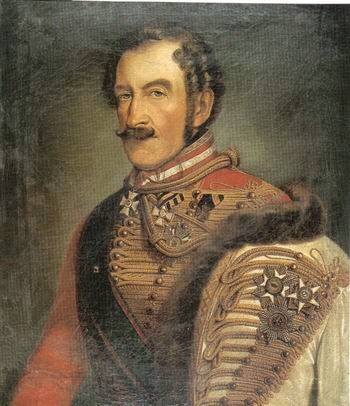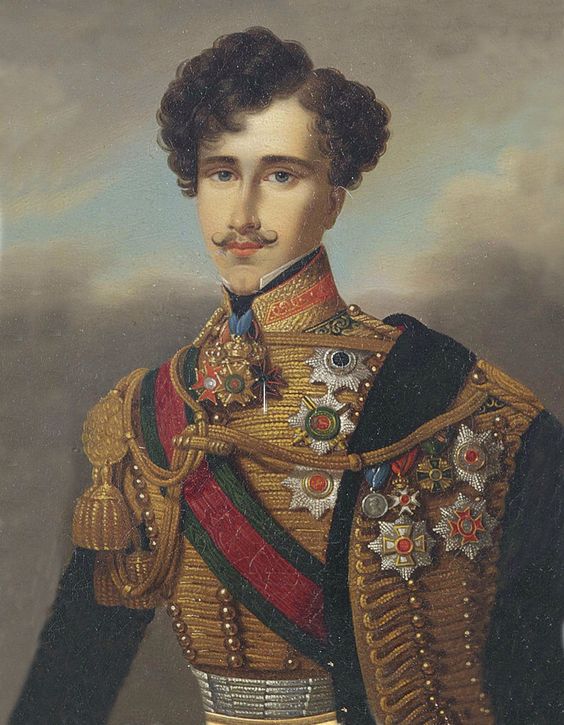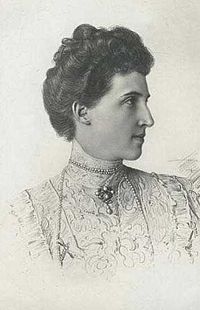by Susan Flantzer
© Unofficial Royalty 2018

Wedding of Matilda of England, King Henry I’s daughter, and Heinrich V, Holy Roman Emperor; Credit – Wikipedia
- Unofficial Royalty: House of Normandy Index
- Unofficial Royalty: House of Angevin Index
- Unofficial Royalty: House of Plantagenet Index
- Unofficial Royalty: House of Lancaster Index
- Unofficial Royalty: House of York Index
The duty of a medieval king was to have sons to succeed to the throne because women were considered unfit to rule. The political advantage of the marriage was the prime consideration – not the looks, the personality or whether the couple liked each other. In Scotland, it was common for the King of Scots to marry a daughter of a Scottish peer but it was not so in England. A foreign alliance was of the utmost importance.
Princesses were often sent off to their wedding without even meeting their future groom. However, royal children were brought up knowing their eventual fate and their duty to king and country. Young princesses were often sent to be brought up in their future husbands’ kingdoms to learn the language and the customs. King Henry I’s daughter Matilda was betrothed to marry Heinrich V, Holy Roman Emperor, who was sixteen years older than her. At the age of eight, she was sent off to Germany and placed into the custody of Bruno, Archbishop of Trier, who educated her in the German language and culture and in the government of the Holy Roman Empire. When the 22-year-old Matilda returned to England as a widow, the courtiers were amazed at how German she had become.
When the eldest daughter of the King of England married, a tax was collected from the barons to provide her with a dowry. The King provided his younger daughters with dowries with his own funds. It was common that royal dowries not only included cash but also land and goods. Proxy betrothals and proxy weddings were often necessary if the royal parents refused to send their daughter away because she was still a child. A proxy marriage was arranged between 28-year-old James IV, King of Scots and twelve-year-old Margaret Tudor, eldest daughter of King Henry VII with Patrick Hepburn, 1st Earl of Bothwell standing in for King James IV. Margaret was exactly the same age as her grandmother Margaret Beaufort had been when she married Edmund Tudor. Margaret Beaufort was determined that her granddaughter not consummate her marriage at such an early age and insisted that Margaret must remain in England until she was older.

The wedding of King Henry VI and Margaret of Anjou; Credit – Wikipedia
The royal bride’s arrival in her new country resulted in massive festivities as soon as she entered the country and continued as she traveled along the roads to the capital. When Margaret of Anjou, the bride of King Henry VI, entered London, she was met with tableaux vivants created and performed by citizens including an allegory of Peace and Plenty, and representations of Noah’s Ark, the Resurrection, and the Last Judgement.
Unfortunately, there is not much information on medieval royal wedding dresses. Most chroniclers were monks who did not describe what the bride wore but a few descriptions do exist. When Elizabeth of Rhuddlan, daughter of King Edward I, married John I, Count of Holland, she wore a gown of embroidered silk with silver gilt buttons and a crown set with rubies, emeralds, and pearls. Documentation from the wedding of Philippa of England, daughter of King Henry IV, and Eric of Pomerania, King of Denmark, Sweden, and Norway indicates that Philippa wore a tunic with a cloak in white silk bordered with gray squirrel and ermine, making her the first documented princess to wear a white wedding dress. When King Edward IV’s sister Margaret of York married Charles the Bold, Duke of Burgundy, she wore a surcoat and mantle of crimson velvet embroidered with gold and a magnificent crown adorned with pearls and enameled white roses for the House of York set between red, green and white enameled letters of her name in Latin.

Crown of Margaret of York in Aachen Cathedral; Photo Credit – By Photo by CEphoto, Uwe Aranas, CC BY-SA 3.0, https://commons.wikimedia.org/w/index.php?curid=34659301
Chroniclers gave no specific account of wedding ceremonies but it can be assumed that the ceremony was the typical Roman Catholic ceremony at that time perhaps with the addition of music. The bride of the King of England was usually crowned Queen right after the wedding ceremony. After the wedding ceremony, the wedding banquet was held. The feasts lasted for several days and included dancing, singing, and jousts. The amount of food consumed was amazing. For the wedding of King Henry III’s daughter Margaret to Alexander III, King of Scots in York, England, the citizens of York contributed all the bread, 200 deer, 300 does, 200 young bucks and 100 boars. The Archbishop of York donated 60 oxen and the King of England’s fishermen gave 230 fish.

Crowning of King Edward III’s bride Philippa of Hainault; Credit – Wikipedia
Weddings of Norman and Plantagenet Kings and Their Children
Some weddings of Kings of England and their children were held in England and some were held in other countries.
- Westminster Abbey was completed around 1060 and was consecrated in 1065. It was the wedding venue for several royal weddings in this time period including that of King Richard II to Anne of Bohemia in 1382. The next royal wedding in Westminster Abbey would be the wedding of Queen Victoria’s granddaughter Princess Patricia of Connaught in 1919.
- Windsor Castle, with its building started by King William I in the decade after the Norman conquest of 1066, was the setting for a few weddings in this time period. King Henry III had built the Chapel of Edward the Confessor there in the early 13th century. However, St. George’s Chapel, the site of many recent royal weddings, was not built there until the late 14th century. Henry III’s Chapel of Edward the Confessor was incorporated into the new chapel. The first wedding at St. George’s Chapel was that of Queen Victoria’s son, the future King Edward VII, in 1863.
- Other wedding venues that have official websites or Wikipedia articles will be linked below. Sometimes the city where the wedding took place is known but the actual wedding venue is unknown.
Note: Only married monarchs and their married children are listed. Links are to Unofficial Royalty articles and only links for monarchs, their children, and their spouses are listed. Note that not all children and spouses have Unofficial Royalty articles.
William I (the Conqueror), King of England, Duke of Normandy married (1053) Matilda of Flanders at the Cathedral of Notre Dame in Eu, Normandy now in France
- Robert Curthose, Duke of Normandy married (1100) Sybil of Conversano in the bride’s hometown of Apulia, now in Italy
- Constance of Normandy married (1087) Alan IV, Duke of Brittany in Caen, Normandy
- Adela of Normandy married (1081) Stephen II, Count of Blois, in Breteuil. Normandy
Henry I, King of England (son of William I) (1) married (1100) Edith of Scotland (renamed Matilda upon her marriage) at Westminster Abbey; (2) married (1121) Adeliza of Louvain at Windsor Castle
- William Ætheling married (1119) Matilda of Anjou in Lisieux, Normandy
- Matilda of England (1) married (1114) Heinrich V, Holy Roman Emperor at Mainz Cathedral now in Germany; (2) married (1128) Geoffrey of Anjou at the Cathedral of Saint Julian of Le Mans now in France
Stephen, King of England (grandson of William I) married (1125) Matilda of Boulogne, wedding venue unknown but probably in France
- Eustace IV, Count of Boulogne married (1140) Constance of France, in Paris, France
- William of Blois, Count of Boulogne, Earl of Surrey (married 1148) Isabel de Warenne, 4th Countess of Surrey, wedding venue unknown
- Marie I, Countess of Boulogne married (1160) Matthew of Alsace, wedding venue unknown
Henry II, King of England (grandson of Henry I) married (1152) Eleanor, Duchess of Aquitaine in Poitiers in the County of Poitou
- Henry the Young King married (1160) Marguerite of France in Rouen, Normandy
- Matilda of England married (1168) Heinrich the Lion, Duke of Saxony and Bavaria at Minden Cathedral now in Germany
- Geoffrey II, Duke of Brittany married (1181) Constance, Duchess of Brittany, wedding venue unknown
- Eleanor of England married (1177) King Alfonso VIII of Castile at Burgos Cathedral in Spain
- Joan of England (1) married (1177) King William II of Sicily 1177 at Palermo Cathedral in Sicily (Italy); (2) married (1196) Raymond VI, Count of Toulouse in Rouen, Normandy
Richard I, King of England (son of Henry II) married (1191) Berengaria of Navarre at the Chapel of St George in Limassol, Cyprus
John, King of England (son of Henry II) (1) married (1189) Isabella, Countess of Gloucester at Marlborough Castle in Wiltshire, England (marriage annulled); (2) married (1200) Isabella of Angoulême in Bordeaux in the Duchy of Aquitaine
- Richard, Earl of Cornwall (1) married (1231) Isabel Marshal at St. Mary the Virgin’s Church in Fawley, England (2) married (1243) Sanchia of Provence at Westminster Abbey (3) married (1269) Beatrice of Falkenburg in Stiftkirche in Kaiserslautern now in Germany
- Joan of England married (1221) Alexander II, King of Scots at York Minster in York, England
Isabella of England married (1235) Friedrich II, Holy Roman Emperor in Worms Cathedral now in Germany - Eleanor of England (1) married (1224) William Marshal, 2nd Earl of Pembroke at the Temple Church in London (2) married (1238) Simon de Montfort, 6th Earl of Leicester in the private chapel at the Palace of Westminster in London
Henry III, King of England (son of King John) married (1236) Eleanor of Provence at Canterbury Cathedral in Canterbury, England
- Margaret of England (1251) married Alexander III, King of Scots at York Minster in York, England
- Beatrice of England married (1260) John II, Duke of Brittany at the Basilica of St. Denis in Paris, France
- Edmund Crouchback, 1st Earl of Lancaster (1) married (1269) Aveline de Forz at Westminster Abbey; (2) married (1276) Blanche of Artois in Paris, France
Edward I, King of England (son of Henry III) (1) married (1254) Eleanor of Castile at the Abbey of Santa María la Real de Las Huelgas in Burgos, Castile (now Spain) (2) married (1299) Margaret of France at Canterbury Cathedral in Canterbury, England
- Eleanor of England married (1293) Henry III, Count of Bar in Bristol Cathedral in England
- Joan of Acre (1) married (1290) Gilbert de Clare, Earl of Hertford at Westminster Abbey (2) married (1297) Ralph de Monthermer, wedding venue unknown
- Margaret married (1290) John II, Duke of Brabant at Windsor Castle
- Elizabeth of Rhuddlan (1) married (1297) John I, Count of Holland in Ipswich, England (2) married (1302) Humphrey de Bohun, Earl of Hereford at Westminster Abbey
- Thomas of Brotherton, Earl of Norfolk married (1326) Alice de Hales in Loddon, Norfolkshire, England
- Edmund of Woodstock, Earl of Kent married (1325) Margaret Wake, 3rd Baroness Wake of Liddell, wedding venue unknown
Edward II, King of England (son of Edward I) married (1308) Isabella of France in Boulogne, France
- Eleanor of Woodstock married (1332) Reinoud II, Count of Guelders in Nijmegen in the County of Guelders now in the Netherlands
- Joan of The Tower married (1328) King David II of Scotland in 1328 at Berwick-upon-Tweed, England
Edward III, King of England (son of Edward II) married (1328) Philippa of Hainault at York Minster in York, England
- Edward, Prince of Wales, the Black Prince married (1361) Joan of Kent, 4th Countess of Kent at Windsor Castle
- Isabella of England married (1365) Enguerrand VII de Coucy, 1st Earl of Bedford at Windsor Castle
- Lionel of Antwerp, 1st Duke of Clarence (1) married (1342) Elizabeth de Burgh, 4th Countess of Ulster at the Tower of London (2) married (1368) Violante Visconti in Milan, Italy
- John of Gaunt, 1st Duke of Lancaster (1) married (1359) Blanche of Lancaster in the Queen’s Chapel at Reading Abbey (2) married (1371) Infanta Constance of Castile in Roquefort, France (3) married (1396) Katherine Swynford (formerly his mistress) at Lincoln Cathedral
- Edmund of Langley, 1st Duke of York (1) married (1372) Infanta Isabella of Castile at Wallingford, Oxfordshire, England (2) married (1393) Joan Holland, wedding venue unknown
- Mary of Waltham married (1361) John V, Duke of Brittany at Woodstock Palace in Woodstock, Oxfordshire, England
- Margaret of Windsor married (1359) John Hastings, 2nd Earl of Pembroke in Reading, England
- Thomas of Woodstock, 1st Duke of Gloucester married (1376) Eleanor de Bohun, wedding venue unknown
Richard II, King of England (grandson of Edward III) (1) married (1382) Anne of Bohemia at Westminster Abbey (last royal wedding at Westminster Abbey until the wedding of Queen Victoria’s granddaughter Princess Patricia of Connaught in 1919) (2) married (1396) Isabella of Valois at the Church of St. Nicholas in Calais, France
Henry IV, King of England (grandson of Edward III) (1) married (1380) Mary de Bohun at Arundel Castle in West Sussex, England (2) married (1403) Joan of Navarre at Winchester Cathedral (Note: Mary de Bohun died before Henry became king. She was the mother of all his children.)
- Thomas of Lancaster, Duke of Clarence married (1411) Margaret Holland, wedding venue unknown
- John of Lancaster, Duke of Bedford (1) married (1423) Anne of Burgundy in Troyes, France (2) married (1433) Jacquetta of Luxembourg in Thérouanne, France
- Humphrey, Duke of Gloucester (1) married (1423) Jacqueline, Countess of Hainaut and Holland in Hadleigh, Essex, England (2) married (1428) Eleanor Cobham
- Blanche of England married (1402) Louis III, Elector Palatine at Cologne Cathedral now in Germany
- Philippa of England married (1406) Eric of Pomerania, King of Denmark, Norway and Sweden at Lund Cathedral in Lund, Sweden
Henry V, King of England (son of Henry IV) married (1420) Catherine of Valois in Troyes, France
Henry VI, King of England (son of Henry VI) married (1445) Margaret of Anjou at Titchfield Abbey in Titchfield, Hampshire, England
- Edward of Westminster, Prince of Wales married (1470) Lady Anne Neville at Angers Cathedral in France
Edward IV, King of England (great-great-grandson of Edward III) married (1464) Elizabeth Woodville at Elizabeth’s family home in Grafton Regis, Northamptonshire, England
- Elizabeth of York married (1486) Henry VII, King of England in St. Stephen’s Chapel in the Palace of Westminster
- Cecily of York (1) married Ralph Scrope of Upsall, wedding venue unknown (2) married (1487) John Welles, 1st Viscount Welles, wedding venue unknown (3) married (circa 1502-1504) Sir Thomas Kyme, wedding venue unknown
- Anne of York married (1495) Thomas Howard at Greenwich, England (after Anne’s death was 3rd Duke of Norfolk)
- Catherine of York married (1495) William Courtenay, 1st Earl of Devon, wedding venue unknown
Richard III, King of England (great-great-grandson of Edward III, brother of Edward IV) married (1472) Lady Anne Neville in St. Stephen’s Chapel in the Palace of Westminster
Works Cited
- Ashdown, D. (1981). Royal Weddings. London: Robert Hale Limited.
- Genealogics.org. (2018). [online] Available at: http://www.genealogics.org [Accessed 2 Apr. 2018].
- Unofficial Royalty. (2018). Unofficial Royalty. [online] Available at: https://www.unofficialroyalty.com [Accessed 2 Apr. 2018]. (for wedding venue and genealogy information)
- Westminster-abbey.org. (2018). Westminster Abbey » Home. [online] Available at: http://www.westminster-abbey.org/home [Accessed 2 Apr. 2018]. (for wedding venue information)
- Wikipedia. (2018). Main Page. [online] Available at: https://en.wikipedia.org/ [Accessed 2 Apr. 2018]. (for wedding venue and genealogy information)
This article is the intellectual property of Unofficial Royalty and is NOT TO BE COPIED, EDITED, OR POSTED IN ANY FORM ON ANOTHER WEBSITE under any circumstances. It is permissible to use a link that directs to Unofficial Royalty.

























